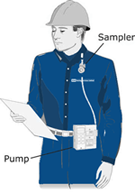
Three pressurized ionization chambers for measuring gamma energy are in use at Stations 400, 401, and 403. The stations-which are similar in design to the Community Environmental Monitoring Program (CEMP) stations operating at locations surrounding the Nevada National Security Site and TTR-include meteorological instruments and continuous-flow, low-volume air samplers. The stations are generally downwind of the contaminated areas during either northwesterly or southerly winds, which are the predominant wind directions. Stations 404 and 405 are along the northern and eastern boundary fence, respectively, at Clean Slate II. Stations 401 and 403 are located on the northern and southeastern perimeter fence lines, respectively, of the Clean Slate III site. Station 400, located within TTR Area 3 and near the ROC, monitors conditions near the local workforce center. The monitoring program in 2018 included five stations. The primary objective of more » the monitoring effort is to support the DOE Environmental Management Nevada Program (EM NV) in the safe remediation of the environmental legacy of nuclear device development and testing by determining if wind blowing across the Clean Slate sites is transporting particles of radionuclide-contaminated soil beyond the physical and administrative boundaries of the sites, and to provide information for designing long-term monitoring of the sites. This report documents observations made during ongoing monitoring of radiological, meteorological, and dust conditions at stations installed adjacent to the Clean Slate sites and at the TTR Sandia National Laboratories (SNL) Range Operations Center (ROC). This operation resulted in radionuclide-contaminated soils at the Double Tracks site and Clean Slate I, II, and III sites. Department of Energy (DOE) (formerly the Atomic Energy Commission ), implemented Operation Roller Coaster on the Tonopah Test Range (TTR) and an adjacent area of the Nevada Test and Training Range (NTTR) (formerly the Nellis Air Force Range). However, measurements made of the activity present on the PAS cellulose fiber filters were consistently underestimated using a gas-flow proportional counter, suggesting a small correction factor of 15-20% to account for the absorption of alpha particle emissions.

27 refs., 15 figs., 18 = 30% of the alpha spectrometry measurements. Other information on practical aspects of personal air sampling and related exposure control efforts are presented in the report. These studies indicate that although breathing-zone activity measurements might provide the best (although not always accurate) means to estimate intake, estimates of uptake and internal dose usually should be made with bioassay or whole body counting. Research concerning the applicability of air-sampling measurements for estimating intake, uptake, and internal dose was also reviewed. The research literature emphasized that estimates of an individual's exposure may be greatly underestimated if based on general area air samples, as is common practice in current licensee programs, due to the unpredictable variability of airborne-activity concentrations in the worksite. The performance tests show that personal air samplers are available which can provide a reliable, convenient means for breathing-zone sampling of workers in practically any work environment which might be encountered in the licensee industries.

The recommendations are based on performance tests of currently available samplers, a review of research and regulatory literature, and a survey of current licensee air-sampling programs. Recommended applications for personal air sampling in NRC licensee radiation protection programs are presented.


 0 kommentar(er)
0 kommentar(er)
